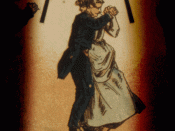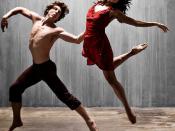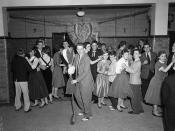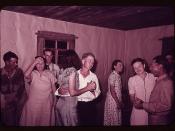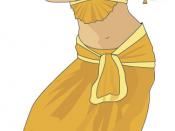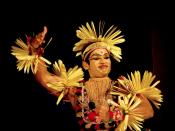Dance is a special form of performing art which uses body motions and an aesthetic form to express and communicate. The physical, intellectual and psychological demands of dancing are compatible to those most strenuous sports and as a result sometimes do not always set realistic expectations of dancers. Dance movements require explosive power, sustained effort and endurance.
Female dancers suffer from eating disorders, amenorrhoea and osteoporosis. Dancers often start training at an early age thus placing unique stresses on their musculoskeletal system during their period of growth and development. Years of dedication, perseverance and intense practice are required before one can achieve the status of an elite dancer.
The knowledge of medical problems of dancers has expanded greatly in the past two decades and dance medicine is developing into a subspecialty in itself.
Most injuries which occur from dance are minor injuries or overuse problems because of the high physical demand on dancers the resultant functional disability in dancers is significant.
The mental stress involved in coping with injuries can never be accurately measured. Many dancers tend to continue to dance or return to full performance before adequate recovery and rehabilitation thus perpetuating the problem.
The majority of dance injuries are overuse injuries which develop slowly over time. Tendinopathies, strains and sprains are commonly seen. The mechanism of these injuries are related to the repetitive movements and loading. Insufficient warm-up, fatigue and technical error were cited as contributing factors to dance injuries. Inappropriate or ill-maintained dance floors, an unconditioned body and low environmental temperatures may also play a role. Recognition and diagnosis of these injuries are often delayed as dancers tend to ignore and tolerate minor systems. Problems are often not brought to medical attention for fear of the need to suspend dancing.
âÂÂSAFETY CODE FOR DANCEDance Safe CodePractice safe warm-up/cool-down procedures appropriate to the style of dance as an integral part of lesson planning.
Be aware of the various types of stretching (appropriate to the style or genre) and be able to identify their advantages and disadvantages.
Sequence dance exercises effectively and safely.
Identify risk factors in dance exercises and technique relevant to the style of dance and to individual students.
Provide a safe dance environment, e.g. venue, floors, facilities. The dance location should be a flat area, free from stones and loose objects, even, firm, not slippery, large enough for the dance activity and the number of students participating kept clear of Stereo sound equipment and props not in use.
Young dancers need to secure or remove any loose apparel, jewellery and other ornaments that may cause injury to themselves and/or other participants. Also long hair should be pulled back if it is likely to impair visionwear and wear appropriate clothing and footwear suitable to the dance activity and the floor surface.
Should out-of-class practice be necessary, advise use of safe environment.
Be aware of common dance injuries as relevant to the style or genre.
Implement current injury recovery and rehabilitation procedures when necessary.
Correctly use basic First Aid procedures. An appropriate First Aid kit should be available and readily accessible.
Dancers should condition the body effectively so injuries can be avoided. By developing strength, flexibility, cardiovascular endurance and adjunctive training (e.g. swimming, cycling) along with maintaining a balanced diet.
Dance Teachers:Teachers need experience, knowledge and/or qualifications required by the levels and techniques to be taught.
Teachers need to use adequate and flexible teaching skills to create a productive learning environment. They will:-demonstrate professional attitudes, including punctuality, reliability and responsible care of students-strive to develop self-discipline and self-motivation in the students-encourage and support the individual in the class situation-transmit general concepts of movement in addition to those of a particular dance style.
Endeavour to recognise physical anomalies, modifying the teaching and seeking medical advice when necessary. The teaching and choreography must be anatomically safe, and teachers must be prepared to deal with medical emergencies.
Training drills need to be varied to avoid overuse injuries and maintain high levels of interest amongst players.
Teachers need to ensure dancers participate in appropriate warm-up and cool down activities to prevent injuries.
âÂÂParents:If children are interested, encourage them to dance. However, if children are not willing to dance, do not force them.
Focus upon the child's efforts and performance rather than the overall outcome of the examination, performance or audition. This assists children in setting realistic goals related to their ability by reducing the emphasis on winning.
Teach children that an honest effort is as important as a victory, so that the results of each examination or performance are accepted without undue disappointment.
Encourage children to always participate according to the rules.
Never ridicule or yell at a child for making a mistake or not passing an examination.
Remember, children learn best from example. Applaud good performances by all of the performers.
If parent disagree with an examiner, adjudicator or critic, raise the issue through the appropriate channels rather than question the official's judgment in public.
Support all efforts to remove verbal and physical abuse from dance activities.
Management of Dance InjuriesThe medical personnel managing dance injuries have to be aware of the high physical demands placed in dancers, their aspirations and the mental stress they have to endure. The physician must be sympathetic to their desire to return to dancing as early as possible and understand their tendency to perform beyond their capabilities. The aim of the management is to make the correct diagnosis, identifying contributing factors, rehabilitate the dancers and most important prevent future reoccurrences. Knowledge of the specific requirement of different dance forms and their specific risks is most helpful.
Most injuries are minor or overuse injuries which can be managed conservatively.
From the dancer's perspective, any time away from dancing can mean loss of physical fitness, loss of performance and roles, withdrawal from the dance environment and loss of confidence.
From management's perspective, an injury means loss of a dancer in a role, unexpected changes in the casting and extra rehearsals for another dancer(s), all of which have financial implications. To reduce the internal tensions that may arise, dance companies have adopted a policy whereby injuries are quickly reported to management. This enables management to instigate contingency plans as early as possible. Unfortunately, within the dance world there is a prevailing belief and attitude that suspects the injured dancer of malingering. The dancer undergoing treatment invariably becomes labelled "injured" and also risk being labelled 'unreliable', 'always injured' or 'weak'. The negative labelling is not only dangerous to self-esteem and confidence of the rehabilitating dancer but also for motivation. Negative labelling can seriously damage a dancer struggling to come to terms with a difficult injury.
One approach that has been adopted to view rehabilitation as a positive learning experience: as a time of education for the prevention of further injury. Also the dancer can use the time away from dance as an opportunity to work on weak areas of the body, on technique and flexibility, strength and coordination. This positive approach towards injury rehabilitation requires a shift in attitude and mindset for both dancers and management.
BibliographyPreventing Dance Injuries 2nd Edition ÃÂ Solomon & MintonOutcomes 2 3rd Edition - Ruskinhttp://www.ausdance.org.au/professional_practice/ethics.htmlhttp://arts.unitec.ac.nz/resource-exchange/resources/Safedancepractice.pdfhttp://davidandjacob.com/art/wp-content/uploads/2008/08/Safe_Dance_Practice.pdfhttp://www.geocities.com/sd_au/BodyWorks/injury1.htmhttp://www.humankinetics.com/products/showproduct.cfm?isbn=9780736055673http://www.oppapers.com/essays/Safe-Dance-Practices/155574http://education.qld.gov.au/strategic/eppr/health/hlspr012/dance.htmlhttp://wehelpwhathurts.homestead.com/dance.htmlhttp://www.medscape.com/viewarticle/441076_sidebar1
